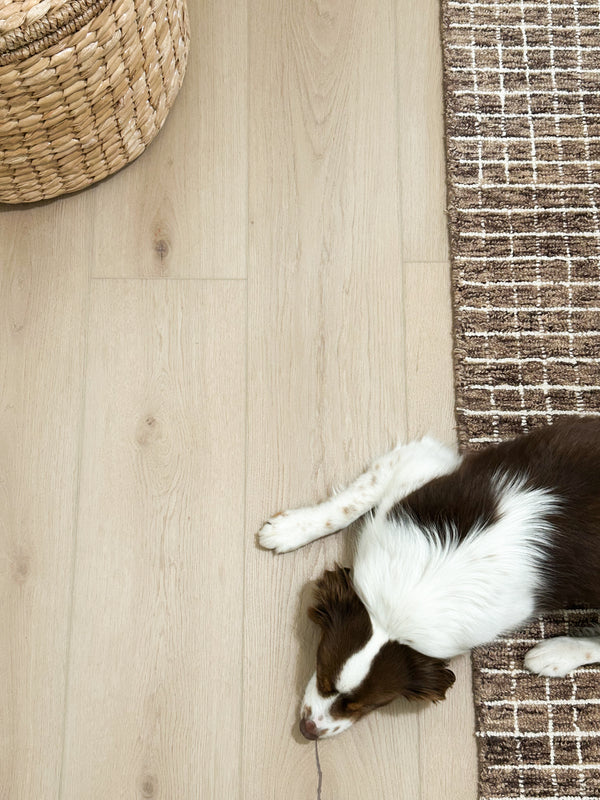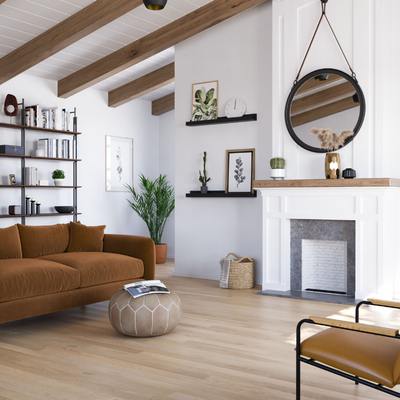Choosing the flooring to put in your home is a big decision.
After all, it’s going to be the base you build the rest of your decor on, it’s something you’re going to see and walk on every day, and it’s something that, unless you’re ready to invest in some serious area rugs, you cannot easily cover up.
This is why, when it comes to flooring, most buyers want something that is not only going to be durable and easy to maintain but also beautiful and stylish.
And if you’re of the age that remembers shag carpeting (remember those cute little rakes?), then you know that some flooring options quickly lose their appeal as time goes on and trends change.
This is why most homeowners opt for flooring with staying power, which will look good and bring joy for many years. For many, that means hardwood flooring or an LVP that mimics that classic hardwood look.
But are all wood-look floors made equally? Does one shade have more staying power than another?
If your sights are set on a light-colored floor, you may ask yourself if that shade will appear dated far sooner than you’d like.
Luckily, we can answer that question for you. Light-toned flooring is an excellent choice for virtually every space, one that has been popular throughout history and one that, we believe, will remain popular for generations to come.
Let’s dive into the historical context that proves that light-colored flooring is a choice that ensures both longevity and enduring beauty in your home.
Hardwood Flooring Throughout History
Flooring has come a long way since the dirt and straw floors of ancient times.

Featured: Nakan Signature from the Modin LVP Collection
The Medieval Era saw the rise of wooden plank flooring in well-to-do households, a symbol of immense wealth or nobility since hardwood planks were extremely expensive and time-consuming to make. Wood had to be sourced and cut, and then planks were individually scraped, sanded, and polished by hand.
The costliness and difficulty of installation meant that wood floors wouldn’t catch on for common folk until the Industrial Revolution (late 1700s– mid-1800s) when the invention of steam-driven machinery and new manufacturing techniques made wooden planks more accessible and affordable.
Between the Medieval Era and the Industrial Revolution, light-colored, wide-planked wooden floors were prevalent in wealthy households around Europe and America. Varnish and stains were not yet commonplace, so floors kept their natural color, and to keep them smooth and clean, they were often scrubbed with sand or whitewashed with lye, resulting in even lighter, bleached colors underfoot.
It is also important to note that the wood used for flooring during this period was limited to what trees grew in the area. White oak, chestnut, and maple were common choices in Europe and America, with the lighter-hued maple being particularly sought after in kitchens for its natural stain-resistant qualities.
After the Industrial Revolution, hardwood floors began to gain widespread popularity, both due to their increased accessibility and the trends of the time favoring the look, meaning that wood plank floors became a common sight not just in affluent households but in lower-income households as well.

Featured: Soho Craftsman from the Modin LVP Collection
As the 20th century approached, additional improvements in machinery and manufacturing processes made wood flooring even more affordable and provided narrower plank styles (similar to Flooret’s Modin Craftsman line), which soon became a fashionable interior design choice for people of all economic backgrounds.
This narrow plank style would continue gaining momentum, culminating in the light-colored and intricate parquet flooring trend of the Victorian Era (mid-1800s through early 1900s) that lasted well into the 1960s.
20th Century Hardwood Flooring Trends
The first half of the 20th century saw the rise in popularity of synthetic flooring in America, offering consumers even more and cheaper flooring options than had ever been available before.
The invention of PVC (polyvinyl chloride vinyl) in the ‘20s meant a practically limitless design potential in vinyl flooring, allowing it to mimic the look of natural wood and stone easily, and by World War II, it had become one of the most popular building materials of its day.
Laminate and linoleum floors came onto the scene in the ‘60s and ‘70s, and their relatively low cost and easy accessibility made them trendy choices in kitchens and bathrooms across the country. The manufacturing process of these flooring materials also made it easy to experiment with different patterns, vibrant colors, and various designs.
However, despite the popularity of patterned linoleum and laminate, the classic look of hardwood floors endured. For every home that could be found with playfully-patterned linoleum floors or black-and-white checkered bathrooms, one could find just as many with classic hardwood flooring.
And, as usually happens, fads like patterned flooring soon came to an end.
The 1990s brought the decline of the bright patterns and shag carpeting of the decades before, and hardwood, vinyl, laminate, and engineered wood flooring replaced those fading trends.

Featured: Anza 7" from the Silvan Resilient Hardwood Collection
Tired of linoleum and carpet, homeowners everywhere began ripping up their floors, often finding old wood floors underneath that could be restored to their former glory.
This leads us to one of the most significant advantages of a wood-look floor. History has proven that, while linoleum and other patterned flooring options now look very dated to us modern homeowners, hardwood flooring has maintained its classic, timeless look through the decades.
Take a look at these period rooms from the 1700s and notice how their floors would fit just as well in a home today.
Light-colored wood-look floors are a style that has been popular throughout history and is increasing in popularity again today.
In 2023, it is a very common sight to find newly-built homes with LVP floors, especially in living rooms and kitchens, giving home buyers the best of both worlds: a timeless wood-look floor with the durability and ease of maintenance that LVP provides.
And while darker floors are certainly still a popular choice, homebuilders generally prefer the bright, neutral look of light-colored flooring.

Featured: Lachlan Signature from the Modin LVP Collection
Beige, gray, and blonde floors are more popular than ever, and since they’ve enjoyed this popularity since the Medieval Era, it stands to reason that they will always hold the spotlight.
Benefits of Light Flooring
There are many reasons that light-colored flooring has stood the test of time. No matter what decade or century, light flooring shades have been popular for many reasons.
Bright and Airy Aesthetic — Light-colored flooring has an unmatched ability to create an open and spacious atmosphere in a room. Light shades, like beige, blonde, or gray, reflect the light and make spaces appear larger and more inviting.
Versatility — One of the biggest advantages of installing light-colored flooring in your home is its versatility. Much like how white can be matched with any color in design and clothing, light-colored floors serve as a neutral canvas that allows you to experiment with the décor of your home.
From different color schemes, furniture styles, and decorations, any cosmetic change made in your home blends seamlessly with a light floor.

Featured: Yuzen Base from the Modin LVP Collection
A Classic Look — The soft, muted tones of a light-colored floor does the trick for homeowners wanting an elegant and timeless look.
While the bold, vibrant carpets and patterned linoleum of the ‘50s, ‘60s, and ‘70s eventually went out of style, light colors have weathered the storm and remained popular.
Durability — Another reason light-colored flooring, especially wood-look styles, has remained popular is its ease of maintenance. Scratches that are more obvious on darker flooring shades are not as noticeable on lighter shades, keeping your floor looking as pristine as ever.
Resale Value — Light-colored, neutral flooring is a good investment for your home. If you ever decide to sell, your light floors can add value and easily allow a buyer to see more potential in your home.
Light-Colored Floors: Interior Design to Stand the Test of Time
If you’re looking for a timeless flooring choice in your home that will never look dated or go out of style, history has indicated that a light-colored wood-look floor is a very safe choice.

Featured: Soho Signature from the Modin LVP Collection
LVP floors not only replicate the timeless appeal of hardwood with remarkable accuracy but also offer significant cost savings to you. And not only is our Modin Rigid LVP Collection nice to look at, but it’s also exceptionally durable, resistant to scratches, and much easier to clean and maintain than a traditional hardwood floor.
If the timeless hardwood look and ease of maintenance are what you’re seeking, we carry LVP flooring in various shades, from light blonde to ash to dark walnut and espresso.
For those looking to bring a touch of nature into their home, our Silvan Resilient Hardwood Collection combines the luxury of natural hardwood with superior durability, sustainable sourcing, and affordable pricing. It’s also backed by a topically-waterproof guarantee so that you can enjoy your hardwood flooring in every space.
The look of hardwood flooring has indeed stood the test of time, and whatever texture or shade you choose from our wide selection, we are confident that your floors will look stunning for years to come.












